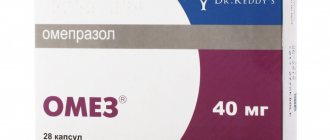Pharmacological properties of the drug Omez d
A combined drug whose effect is determined by the components included in its composition. Omeprazole is an antisecretory antiulcer agent that reduces spontaneous and stimulated gastric secretion due to inhibition of H+/K+-ATPase (proton pump), necessary for the transport of hydrogen ions, and inhibits the final phase of basal and stimulated secretion of hydrochloric acid, regardless of the nature of the stimulus. Domperidone is a dopamine receptor antagonist, prokinetic. Practically does not penetrate the BBB. Increases the motor-evacuation function of the stomach and duodenum and the tone of the lower esophageal sphincter. Does not increase the secretion of glands of the digestive tract. Has an antiemetic effect. Omeprazole is quickly and completely absorbed from the gastrointestinal tract after oral administration on an empty stomach; when taken after meals, absorption may increase. Although the half-life of omeprazole is short (0.5–1.5 hours), the antisecretory effect persists for ≥24 hours. Omeprazole quickly (within 4 hours) distributes to the gastric mucosa, liver and gallbladder tissues. After 48 hours, omeprazole is detected only in the gastric mucosa. Approximately 90–95% of omeprazole is bound to plasma proteins. A small amount penetrates the BBB. The majority (77%) is excreted in the urine in the form of metabolites (of which hydroxyomeprazole and the corresponding carboxylic acid are identified). The remaining amount is excreted in the feces (a significant part of the metabolites is excreted in the bile). Three metabolites of omeprazole have been identified in blood plasma - sulfide and sulfone derivatives of omeprazole. They have weak antisecretory activity or none at all. The active metabolite is sulfonomeprazole. In patients with chronic liver diseases, the bioavailability of the drug increases to 100%, and the half-life increases to 3 hours. In patients with chronic kidney diseases and elderly patients, the elimination of omeprazole decreases in proportion to the decrease in creatinine clearance, and the concentration in the blood plasma increases. Domperidone is well absorbed from the gastrointestinal tract after administration. It undergoes intensive metabolism in the wall of the stomach and liver and has low bioavailability (15%). The maximum concentration in blood plasma is achieved 1 hour after application. A decrease in gastric acidity reduces the absorption of domperidone. Binds to plasma proteins by 91–93%. Excreted in feces (66%) and urine (33%). The half-life is 9 hours, and increases with severe renal failure.
Omez D (N30)
MINISTRY OF HEALTH OF THE RUSSIAN FEDERATION INSTRUCTIONS for the use of the medicinal product for medical use OMEZ® D
Registration number: LSR-001303/08 Trade name of the drug: Omez® D International nonproprietary or generic name: domperidone + omeprazole Dosage form : capsules Composition: one capsule contains: active ingredients: domperidone 10.00 mg, omeprazole 10.00 mg (in in the form of enteric-coated pellets (8.5% w/v 117.65 mg)*; excipients: microcrystalline cellulose (Avicel pH 102) 65.00 mg, magnesium stearate 6.00 mg, colloidal silicon dioxide 2.00 mg , sodium carboxymethyl starch 3.50 mg, sodium lauryl sulfate 0.50 mg, talc 3.00 mg *composition of omeprazole pellets (8.5% w/v): active ingredient: omeprazole 10.00 mg; excipients: mannitol 23.53 mg, sucrose 32.32 mg, sodium dihydrogen orthophosphate 1.53 mg, sodium lauryl sulfate 0.32 mg, lactose 4.71 mg, calcium carbonate 4.71 mg, hypromellose 10.00 mg, propylene glycol 0.47 mg, methacrylic acid ( 1-30 D 55) 23.53 mg, polysorbate (Tween-80) 0.21 mg, diethyl phthalate 0.94 mg, sodium hydroxide 0.21 mg, cetyl alcohol 0.47 mg, starch 4.71 mg composition empty solid gelatin capsule: cover: indigo karmin 1.000%, carmosine 5,000%, dioxide titanium 1.998%, methyl parahydrocybenzoate (methylparaben) 0.800%, propyl parahydrogybenzoate 0.200%, sodium lauryl sulfate 0.0834%, gelatin qs up to 100%, water 14.5.5.5.5.5.5.5.5.5.5.5.5.5.5.5.5. ±1.5%; body: titanium dioxide 2.166%, methyl parahydroxybenzoate (methylparaben) 0.800%, propyl parahydroxybenzoate (propylparaben) 0.200%, sodium lauryl sulfate 0.0834%, gelatin qs up to 100%, water 14.5±1.5%.
Pharmacotherapeutic group: reflux esophagitis combined treatment (proton pump inhibitor + central dopamine receptor blocker).
ATX Code: A02BX Description Hard gelatin capsule No. 2 with a light purple cap and a white body with the inscription “Omez D” and the DR.REDDY'S logo on the capsule shell containing white or almost white pellets, white or almost white particles and powder.
Pharmacological properties Pharmacodynamics
Domperidone Increases the duration of peristaltic contractions of the antrum of the stomach and duodenum, accelerates gastric emptying if this process slows down, increases the tone of the lower esophageal sphincter, and eliminates the development of nausea and vomiting. Stimulates the release of prolactin from the pituitary gland. The antiemetic effect may be due to a combination of peripheral (gastrokinetic) action and antagonism of dopamine receptors in the trigger zone of the brain. Domperidone has no effect on gastric secretion. Domperidone does not penetrate the blood-brain barrier well, so the use of domperidone is rarely accompanied by the development of extrapyramidal side effects, especially in adults.
Omeprazole Inhibits the enzyme H+/K+-ATPase (“proton pump”) in the parietal cells of the stomach and thereby blocks the final stage of hydrochloric acid synthesis. This leads to a decrease in the level of basal and stimulated secretion, regardless of the nature of the stimulus. After a single dose of the drug orally, the effect of omeprazole occurs within the first hour and continues for 24 hours, the maximum effect is achieved after 2 hours. After stopping the drug, secretory activity is completely restored after 3 to 5 days. Due to a decrease in the secretion of hydrochloric acid, the concentration of chromogranin A increases (see section “Special instructions”).
Pharmacodynamic rationale for the combination Omeprazole suppresses the secretion of hydrochloric acid, domperidone increases the tone of the lower esophageal sphincter and accelerates gastric emptying, thereby reducing the activity of aggressive factors of gastric juice and the reflux of gastric contents into the esophagus. Pharmacokinetics
Domperidone Absorption. After oral administration, domperidone is rapidly absorbed. It has low bioavailability (about 15%). Reduced acidity of gastric contents reduces the absorption of domperidone. The maximum concentration in plasma is reached after 1 hour. Distribution. Domperidone is widely distributed in various tissues; its concentration in brain tissue is low. Communication with plasma proteins is 91-93%. Metabolism. Subject to intensive metabolism in the intestinal wall and liver. Excretion. Excreted through the intestines (66%) and kidneys (33%), unchanged, 10% and 1% of the dose are excreted, respectively. The half-life is 7-9 hours; in cases of severe renal failure, it is prolonged.
Omeprazole Absorption and distribution. Omeprazole is rapidly absorbed from the gastrointestinal tract (GIT), maximum plasma concentration is achieved after 0.5-1 hour. Bioavailability is 30-40%. Plasma protein binding is about 90%. Metabolism and excretion. Omeprazole is almost completely metabolized in the liver. It is an inhibitor of the CYP2C19 isoenzyme. The half-life is 0.5-1 hour. Excreted by the kidneys (70-80%) and bile (20-30%). In chronic renal failure, excretion decreases in proportion to the decrease in creatinine clearance. In elderly patients, excretion decreases and bioavailability increases. In case of liver failure, bioavailability is 100%, half-life is 3 hours.
Indications for use - Dyspepsia associated with delayed gastric emptying, gastroesophageal reflux, esophagitis (feeling of fullness in the epigastrium, feeling of bloating, pain in the upper abdomen; belching, flatulence; nausea, vomiting; heartburn with or without reflux of gastric contents into the oral cavity); - To relieve symptoms of nausea, vomiting, dyspepsia, heartburn, including those associated with gastritis, gastric and duodenal ulcers or gastroesophageal disease.
Contraindications Hypersensitivity to domperidone, omeprazole, substituted benzimidazoles or other components included in the drug ; deficiency of lactase, sucrase/isomaltase, lactose intolerance, fructose intolerance, glucose-galactose malabsorption; gastrointestinal bleeding; mechanical intestinal obstruction, perforation of the stomach or intestines, prolactin-secreting tumor of the pituitary gland (prolactinoma); children under 12 years of age with a body weight of less than 35 kg, moderate to severe liver failure, pregnancy, breastfeeding, simultaneous use of drugs that increase the QT interval and inhibitors of the CYP34A isoenzyme; simultaneous use with erlotinib, posaconazole, nelfinavir, ata after navir, fluconazole, voriconazole, clarithromycin, amiodarone, telithromycin; ketoconazole, erythromycin; severe electrolyte disturbances or heart disease such as chronic heart failure. With caution - renal failure; the presence of “alarming symptoms: significant loss of body weight, repeated vomiting, vomiting with blood, difficulty swallowing, change in the color of stool (tarry stools), and others (see section “Special instructions”); deficiency of vitamin B12 (cyanocobalamin); osteoporosis; simultaneous use with clopidogrel, warfarin, itraconazole, digoxin, cilostazol, diazepam, St. John's wort preparations (see section "Interaction with other drugs")
Use during pregnancy and breastfeeding The use of the drug during pregnancy and breastfeeding is contraindicated.
Method of administration and dosage : Orally, without chewing, with a small amount of water, 1 capsule 2 times a day, 15-20 minutes before meals. It is recommended to take the drug regularly at a certain time. It is recommended to take the minimum effective dose. In patients with mild hepatic impairment, no dose adjustment is required. The drug is contraindicated in patients with moderate to severe liver failure.
Side effects The frequency of side effects is classified according to the recommendations of the World Health Organization: very often (≥ 1/10), often (≥ 1/100, ≤ 1/10), infrequently (≥ 1/1000, ≤ 1/100), rarely (≥ 1/10000, ≤ 1/1000), very rare, (< 1/10000), frequency unknown - based on available data, it is not possible to determine the frequency of occurrence.
Domperidone From the gastrointestinal tract: rarely - gastrointestinal disorders, including transient intestinal spasms; very rarely - diarrhea. From the nervous system: very rarely - extrapyramidal disorders, convulsions, increased excitability and irritability, drowsiness, (in adults the above symptoms are extremely rare), headache. Extrapyramidal disorders are usually reversible and disappear when domperidone therapy is discontinued. From the cardiovascular side: frequency unknown - ventricular arrhythmia, prolongation of the QT interval, ventricular tachycardia of the "pirouette" type, sudden coronary death (see section "Special instructions"). From the skin and subcutaneous tissues: very rarely - skin rash, itching of the skin, urticaria. From the immune system: very rarely - allergic reactions, including anaphylaxis, anaphylactic shock, angioedema, Other: rarely - hyperprolactinemia, galactorrhea, gynecomastia, amenorrhea; very rarely - changes in liver function tests; Omeprazole From the blood and lymphatic system: rarely - leukopenia, thrombocytopenia; very rarely - agranulocytosis, pancytopenia. From the immune system: rarely - hypersensitivity reactions: fever, angioedema, anaphylactic reaction/anaphylactic shock. Metabolism and nutrition: rarely – hyponatremia; very rarely - hypomagnesemia. Mental disorders: infrequently – insomnia; rarely – increased excitability; confusion, depression; very rarely – aggressiveness, hallucinations. From the nervous system: often – headache; uncommon – dizziness, paresthesia, drowsiness; rarely – taste disturbance. From the side of the organ of vision: rarely – blurred vision. Hearing and labyrinthine disorders: uncommon – vertigo. From the respiratory system, chest and mediastinal organs: rarely – bronchospasm. From the gastrointestinal tract: often - abdominal pain, constipation, diarrhea, flatulence, nausea, vomiting; rarely - dry mouth, stomatitis, gastrointestinal candidiasis, microscopic colitis. From the liver and biliary tract: infrequently - increased activity of liver enzymes; rarely – hepatitis (including with jaundice); very rarely - liver failure, encephalopathy in patients with previous liver diseases. From the skin and subcutaneous tissues: infrequently - dermatitis, itching, rash, urticaria; rarely – alopecia, photosensitivity reaction; very rarely - erythema multiforme, Stevens-Johnson syndrome, toxic epidermal necrolysis. From the musculoskeletal and connective tissue side: infrequently - fractures of the hip, wrist bones and vertebrae; rarely – arthralgia, myalgia, very rarely – muscle weakness. From the kidneys and urinary tract: rarely – interstitial nephritis. From the genital organs and breast: very rarely - gynecomastia. General disorders: uncommon – malaise, peripheral edema; rarely – increased sweating. Cases of formation of gastric glandular cysts have been reported during long-term treatment with proton pump inhibitors (a consequence of inhibition of hydrochloric acid secretion, which is benign and reversible).
Overdose of Domperidone Symptoms: increased excitability, drowsiness, convulsions, disorientation and extrapyramidal reactions. Treatment: symptomatic, there is no specific antidote. Gastric lavage, taking activated charcoal, if extrapyramidal reactions occur, use anticholinergic, antiparkinsonian drugs. Due to possible prolongation of the QT interval, the electrocardiogram should be monitored. Omeprazole Symptoms: nausea, vomiting, dizziness, abdominal pain, diarrhea, headache, apathy, depression, confusion, flatulence, tachycardia. Treatment: symptomatic. If necessary, gastric lavage, activated charcoal, hemodialysis is not effective enough.
Interactions with other drugs Domperidone Interactions with the following drugs may increase the risk of QT prolongation: Contraindicated combinations: drugs that prolong the QT interval: class IA antiarrhythmic drugs (eg, disopyramide, hydroquinidine, quinidine), class III antiarrhythmic drugs (eg, amiodarone, dofetilide , dronedarone, ibutilide, sotalol), antipsychotics (eg, haloperidol, pimozide, sertindole), antidepressants (eg, citalopram, escitalopram), antibiotics (erythromycin, levofloxacin, moxifloxacin, spiramycin), antifungals (eg, pentamidine), antimalarials medications (eg, halofantrine, lumefantrine), gastrointestinal medications (eg, cisapride, dolasetron, prucalopril), antihistamines (eg, mechitazine, mizolastine), anticancer medications (eg, remifene, vandetanib , vincamine), other medications (for example, bepridil, difemanil methyl sulfate, methadone), potent CYP3A4 inhibitors (protease inhibitors, azole antifungals, some macrolide antibiotics (erythromycin, clarithromycin, telithromycin)). Not recommended combinations: moderate CYP3A4 inhibitors (diltiazem, verapamil, some macrolide antibiotics). Combinations that should be used with caution: drugs that cause bradycardia and hypokalemia, as well as azithromycin and roxithromycin. Cimetidine, sodium bicarbonate, and other antacid and antisecretory drugs reduce the bioavailability of domperidone. Anticholinergics may counteract the effects of domperidone. Increase the concentration of domperidone in plasma: azole antifungals, antibiotics from the macrolide group, HIV protease inhibitors, nefazodone. Domperidone is compatible with the use of neuroleptics, dopaminergic receptor agonists (bromocriptine, levodopa),
Omeprazole When omeprazole is used together with some antiretroviral drugs, such as atazanavir and nelfinavir, a decrease in their plasma concentration is observed. In this regard, the combined use of omeprazole with atazanavir and nelfinavir is contraindicated. With simultaneous use of omeprazole and saquinavir/ritonavir, an increase in saquinavir plasma concentrations was observed. The bioavailability of digoxin when used simultaneously with omeprazole increases by 10% (adjustment of the dosage regimen may be required). Caution should be exercised when these drugs are used concomitantly in elderly patients. With simultaneous use of omeprazole with clopidogrel, a decrease in the antiplatelet effect of the latter is observed. Therefore, the combined use of omeprazole and clopidogrel should be avoided . Like other drugs that reduce gastric acidity, treatment with omeprazole may lead to decreased absorption of ketoconazole, itraconazole, posaconazole, erlotinib, iron supplements and cyanocobalamin. should be avoided . When used simultaneously with omeprazole, it is possible to increase the plasma concentration and increase the half-life of warfarin, diazepam, phenytoin, cilostazol, imipramine, clomipramine, citalopram, hexobarbital, disulfiram, as well as other drugs metabolized in the liver with the participation of the CYP2C19 isoenzyme (a dose reduction of these drugs may be required ). When methotrexate was co-administered with proton pump inhibitors, a slight increase in plasma methotrexate concentrations was observed in some patients. When treated with high doses of methotrexate, omeprazole should be temporarily discontinued. With the simultaneous use of omeprazole and tacroliamus, an increase in the concentration of tacrolimus in the blood plasma was noted, which may require adjustment of its dose. When omeprazole is taken together with inhibitors of the CYP2C19 and CYP3A4 isoenzymes (such as clarithromycin, erythromycin, voriconazole ) , the concentration of omeprazole in the blood plasma increases. Inducers of the CYP2C19 and CYP3A4 isoenzymes, such as rifampicin, preparations of St. John's wort (Hipericum perforatum), when used together with omeprazole, can lead to a decrease in the concentration of omeprazole in the blood plasma by accelerating the metabolism of omeprazole. Co-administration of omeprazole with amoxicillin or metronidazole does not affect the concentration of omeprazole in the blood plasma. There was no effect of omeprazole on antacids, theophylline, caffeine, quinidine, lidocaine, propranolol, ethanol.
Special instructions Before starting therapy, it is necessary to exclude the presence of a malignant process, since treatment, masking symptoms, can delay the correct diagnosis. Due to the decrease in hydrochloric acid secretion by omeprazole, the concentration of chromogranin A (CgA) increases. Increased concentrations of CgA in blood plasma may affect the results of examinations to detect neuroendocrine tumors. To prevent this effect, it is necessary to temporarily stop taking omeprazole 5 days before the CgA concentration test. Proton pump inhibitors, especially when used in high doses and long-term use (>1 year), may moderately increase the risk of hip, wrist, and vertebral fractures, especially in patients who are elderly or have other risk factors. Severe hypomagnesemia, manifested by symptoms such as fatigue, delirium, convulsions, dizziness and ventricular arrhythmia, has been reported in patients receiving omeprazole for at least three months. In most patients, hypomagnesemia was relieved after discontinuation of proton pump inhibitors and administration of magnesium supplements. In patients who are planning long-term therapy or are prescribed omeprazole with digoxin or other drugs that can cause hypomagnesemia (for example, diuretics), magnesium levels should be assessed before starting therapy and monitored periodically during treatment. Omeprazole, like all drugs that reduce acidity, can lead to decreased absorption of vitamin B12 (cyanocobalamin). This must be remembered in patients with a reduced supply of vitamin B12 in the body or with risk factors for impaired absorption of vitamin B12 during long-term therapy. Patients taking drugs that reduce the secretion of gastric glands for a long time are more likely to experience the formation of glandular cysts in the stomach, which go away on their own with continued therapy. These phenomena are caused by physiological changes resulting from inhibition of hydrochloric acid secretion. Reduced secretion of hydrochloric acid in the stomach under the influence of proton pump inhibitors or other acid-inhibiting agents leads to an increase in the growth of normal intestinal microflora, which in turn may lead to a slight increase in the risk of developing intestinal infections caused by bacteria of the genus Salmonella spp. and Campylobacter spp., and also possibly Clostridium difficile in hospitalized patients. Domperidone may cause QT prolongation and torsade de pointes (TdP). These adverse reactions were observed mainly in patients with risk factors, with severe electrolyte disturbances, or concomitantly taking drugs that prolong the QT interval. Some studies have shown that the use of domperidone may lead to an increase in ventricular arrhythmias or sudden coronary death (especially in patients over 60 years of age and in patients taking the drug in daily doses of more than 30 mg, as well as in patients taking concomitant drugs QT interval prolongers or CYP3A4 inhibitors). It is not recommended to use domperidone preparations to prevent nausea and vomiting after anesthesia. The use of domperidone and other drugs that can cause prolongation of the QT interval is contraindicated in patients who experience prolongation of cardiac conduction intervals, especially the QT interval, in patients with severe electrolyte disturbances (hypo- and hyperkalemia, hypomagnesemia) or in patients with heart disease. such as chronic heart failure. It has been shown that the presence of electrolyte disturbances (hypo- and hyperkalemia, hypomagnesemia) and bradycardia in a patient may increase the risk of developing arrhythmia. You should stop taking the drug if any symptoms occur that may be associated with cardiac arrhythmias. Domperidone drugs enhance the effect of antipsychotics when used simultaneously with them. With the simultaneous use of domperidone drugs with dopaminergic receptor agonists (bromocriptine, levodopa), there is an inhibition of the unwanted peripheral effects of the latter, such as indigestion, nausea and vomiting, without affecting their central effects. It is recommended to take the drug in the minimum effective dose.
Impact on the ability to drive vehicles and machinery Care should be taken when driving vehicles and engaging in other potentially hazardous activities that require increased concentration and speed of psychomotor reactions due to the risk of developing adverse reactions that may affect these abilities.
Release form Capsules. 10 capsules per aluminum foil strip. 3 strips and instructions for use in a cardboard box.
Storage conditions Store in a dry place, protected from light, at a temperature not exceeding 25°C. Keep out of the reach of children.
Shelf life: 2 years. Do not use after the expiration date indicated on the package.
Conditions of release By prescription. Manufacturer Torrent Pharmaceuticals Ltd., India Torrent Pharmaceuticals Ltd., India Torrent House, Off Ashram Road, Ahmedabad 380 009, India Torrent House, Off Ashram Road, Ahmedabad 380 009, India
Manufacturing address : Torrent Pharmaceuticals Ltd. Torrent Pharmaceuticals Ltd., Indrad-382721, Dist. Mehsana, India / Indrad-382721, Dist. Mehsana, India
Information about complaints and adverse reactions should be sent to the following address: Representative office of Torrent Pharmaceuticals Ltd.: Moscow 117418 st. Novocheremushkinskaya, 61 tel., fax e-mail
Side effects of the drug Omez d
most patients tolerate the drug well. With prolonged use, skin reactions may occur (skin rash, itching, urticaria, erythema multiforme), dry mouth, diarrhea, constipation, intestinal colic, headache, photosensitivity, alopecia, Quincke's edema, dizziness, parasthesia, drowsiness, insomnia, blurred vision , disturbance of taste, agitation, depression, leukopenia, thrombocytopenia, pancytopenia, agranulocytosis, myalgia, arthralgia, bronchospasm, interstitial nephritis, very rarely - galactorrhea, gynecomastia. Domperidone may cause the development of extrapyramidal reactions, especially in young and elderly patients.
Side effects
Both active substances Omez D provoke undesirable effects.
Domperidone
Domperidone has difficulty crossing the blood-brain barrier (BBB), so extrapyramidal reactions are rarely observed only if the permeability of such a barrier is increased, and in childhood.
During treatment, a number of patients report the following side effects:
- intestinal cramps;
- hyperprolactinemia, in which the concentration of prolactin in the blood increases.
Omeprozole
Side effects from the use of omeprozole:
- digestive disorders - constipation or diarrhea, flatulence;
- nausea, vomiting;
- abdominal pain;
- taste disturbances;
- hepatitis, if there is a medical history of severe illnesses and liver dysfunction;
- rarely - formation of gastric cysts;
- CNS disorders (headache, dizziness, depression, hallucinations, sleep disorders, etc.);
- muscle weakness, pain in muscles and joints;
- blood count abnormalities (decrease in the concentration of leukocytes, platelets, etc.);
- skin reactions - itching, increased sweating, hair loss, photosensitivity (sensitivity to solar radiation);
- allergic reactions, including angioedema and anaphylactic shock, bronchospasm;
- visual impairment;
- peripheral edema;
- gynecomastia (breast enlargement in men).
Since Omez D causes drowsiness and other central nervous system disorders in some patients, caution must be exercised when driving or operating other equipment that requires concentration.
Contraindications
Omez D is not used to treat children. The drug is contraindicated if you have been diagnosed with:
- bleeding of the gastrointestinal tract;
- mechanical obstruction, perforation (formation of a hole in the wall) of the stomach or intestines;
- prolactinoma (pituitary tumor);
- increased susceptibility to components.
The medicine should be used with caution in the treatment of patients with renal and hepatic insufficiency.
During pregnancy and breastfeeding
Omez D is prescribed to pregnant women with caution, and it is contraindicated for nursing mothers.
Overdose
The symptoms of an overdose of domperidone and omeprozole are different.
1. Domperidone
Symptoms of exceeding the dose are drowsiness, loss of orientation, extrapyramidal reactions - parkinsonism, dystonia, tremor, etc. Activated charcoal is prescribed as therapy ; if extrapyramidal reactions occur, the patient is given antiparkinsonian and antihistamines.
2. Omeprazole
An overdose of omeprazole is manifested by visual disturbances, drowsiness, confusion, headache, sweating, nausea, heart rhythm disturbances, and dry mouth. In this case, symptomatic treatment is carried out. Hemodialysis is ineffective.
Video on the topic: All about tablets. Omez D
Special instructions for the use of the drug Omez d
Before starting and after completing therapy with Omez D, it is necessary to conduct an endoscopic examination to exclude a malignant process, since treatment with omeprazole can mask its symptoms and delay correct diagnosis. During pregnancy, the drug is used if the expected benefit to the mother outweighs the potential risk to the fetus. If it is necessary to prescribe the drug during breastfeeding, it is advisable to stop breastfeeding. During treatment with the drug, special care should be taken when driving vehicles or working with potentially dangerous mechanisms.
Analogs
Omez D has many analogues, both with omeprozole and domperidone, but only in a different combination, and based on other active substances.
Based on omeprozole:
- Ozol;
- Omealox;
- Omez;
- Omeprazole;
- Proton;
- Ultop.
Based on esomeprazole:
- Nexium;
- Nexpro;
- Pemozar;
- Esomeprazole;
- Emanera.
Based on pantoprazole:
- Panocide;
- Pangastro;
- Nolpaza;
- Control;
- Zolopent;
- Pantor et al.
Interactions of the drug Omez d
Antacids slow down and reduce the absorption of the drug, so they should be taken no earlier than 2 hours after taking Omez D. Since omeprazole is metabolized in the liver through the cytochrome P450 system, it should be prescribed with caution simultaneously with diazepam, phenytoin, warfarin, propranolol, prednisolone , theophylline (while omeprazole may reduce their elimination, which requires a reduction in the doses of these drugs). With simultaneous use of omeprazole and clarithromycin, their concentration in the blood plasma increases. Cimetidine and sodium bicarbonate reduce the bioavailability of domperidone. Anticholinergic drugs counteract the effects of domperidone.
Reviews
In general, patients respond well to Omez D. The advantages include effectiveness, especially in combination with diet, and rapid relief of symptoms.
The disadvantages include the presence of side effects and the large size of the capsules. Some users have noticed that the effect of treatment occurs as part of combination therapy.
The following side effects have been observed:
- menstrual irregularities in women due to increased production of the hormone prolactin;
- stomach ache.
Read detailed reviews about Omez D at the end of the article.









